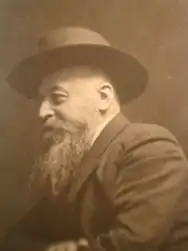
Gustave Fayet (Béziers, May 20, 1865 - Carcassonne, September 24, 1925) was a French painter.[1] His work is close in style to that of Paul Gauguin or Odilon Redon. He learnt to draw and paint with his father, Gabriel Fayet, and his uncle Léon Fayet, who both admired pre-impressionnist painters such as Adolphe Monticelli or Camille Corot. Gustave Fayet's style is very personal, far from impressionism or academic work, rather more symbolism.[2] Gustave Fayet was also an art collector, he owned works by Degas, Manet, Pissarro and above all Paul Gauguin.[3] Fayet was in fact one of Gauguin's main clients and he lent many of the paintings in his collection for the Gauguin exhibitions between 1903 and 1925. In 1908, he bought the Abbaye de Fontfroide (near Narbonne, France), that he reconstructed and where he exhibited many of the paintings from his collection, among them "Day" and "Night" by Odilon Redon.[4][5]
Fayet was a man with a universal curiosity and his work reflects this by a rich variety of styles and techniques. His works remain mainly in private collections and are not widely known by the public. However, since 2005 a "Fayet Room" has been opened in the Abbaye de Fontfroide and in 2006 the museum of Elne (near Perpignan, south of France) held a retrospective exhibition of Fayet's work.
References
- ↑ Jean Pierre Barou (2006). Gustave Fayet, "vous peintre--" (Paul Gauguin, 1902). Indigène éd. ISBN 978-2-911939-57-0. Retrieved 16 August 2013.
- ↑ Hilary Spurling (2001). The Unknown Matisse: A Life of Henri Matisse : The Early Years, 1869-1908. University of California Press. pp. 355–. ISBN 978-0-520-22203-8. Retrieved 16 August 2013.
"Colour has absolute power over Fayet," wrote Andre Suares. "He is possessed by colour; it intoxicates him, it is his delight . . ." He shared the belief in overall design so passionately argued by Gauguin (who had dreamed in the Gustave ...
- ↑ A Picasso Portfolio: Prints from the Museum of Modern Art. The Museum of Modern Art. 2010. pp. 179–. ISBN 978-0-87070-780-3. Retrieved 16 August 2013.
In April 1906, Picasso visited the home of Gustave Fayet, who collected Gauguin's work, including his prints. See Anne Baldassari, chap. 5, in Elizabeth Cowling et al., Matisse Picasso (London: Tate Publishing; New York: Museum of Modem ...
- ↑ Dominique Auzias; Jean-Paul Labourdette; Collectif (27 June 2013). Best of Aude 2013 Petit Futé (avec cartes, photos + avis des lecteurs). Petit Futé. pp. 8–. ISBN 978-2-7469-7080-9. Retrieved 16 August 2013.
The abbey was subjected to a public sale in 1908. Gustave Fayet and his wife Madeleine of Andoque de Sériege, not hesitating to overbid, bought back Fontfroide to save the abbey from an American ownership. This year, the colourful stained ...
- ↑ Dominique Auzias; Jean-Paul Labourdette (23 March 2011). Petit Futé France (in French). Nouvelles Editions de l'Université. p. 233. ISBN 978-2-7469-3107-7. Retrieved 16 August 2013.
Depuis son rachat et son sauvetage par Gustave et Madeleine Fayet en 1908, l'abbaye de Fontfroide est devenue un intense centre culturel et botanique, organisant de nombreuses manifestations tout au long de l'année.